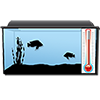




Males of the new species are easily distinguished from H. stenosoma (Boulenger, 1901) based on their adult color pattern, i.e. black vertical bars on the anterior flanks part and posterior horizontal bands on a silvery-whitish body coloration vs. an anterior flank color pattern of black blotches of variable number, size and shape and posterior horizontal bands. Males and females of the new species are further distinguished by their longer lower pharyngeal jaw (37.6–38.2% HL vs. 27.8–32.5% HL) with a characteristically curved keel, which is straight or only slightly curved towards the tips in H. stenosoma. The new species has on average fewer gill rakers on the first gill arch than its only congener (33–37 vs 35–43).
Schedel, Frederic D.B & U.K. Schliewen. 2017. "Hemibates koningsi spec. nov: a new deep-water cichlid (Teleostei: Cichlidae) from Lake Tanganyika". Zootaxa. v. 4312(n. 1), pp. 92-112
Coulter, George W. 1991. "The Benthic Fish Community". Lake Tanganyika and its Life, Natural History Museum Publications, Oxford University Press. pp. 1-354
Kirchberger, Paul & K.M. Sefc, C. Sturmbauer & S. Koblmüller. 2012. "Evolutionary history of Lake Tanganyika’s predatory deepwater cichlids". International Journal of Evolutionary Biology. v. 2012(n. 716209), pp. 10
Koblmüller, Stephan & Nina Duftner, Cyprian Katongo, Harris Phiri & Christian Sturmbauer. 2005. "Ancient Divergence in Bathypelagic Lake Tanganyika Deepwater Cichlids: Mitochondrial Phylogeny of the Tribe Bathybatini". Jounal of Molecular Evolution. no. 60; pp. 297-314
Konings, Ad. 1998. "Tanganyika Cichlids In Their Natural Habitat". Cichlid Press
Konings, Ad. 1988. "Tanganyika Cichlids". Verduijn Cichlids, Holland. pp. 1-272
Smith, Mark. 2007. "Lake Tanganyika Cichlids (2nd Edition)". Barrons Educational Series. 94 pp